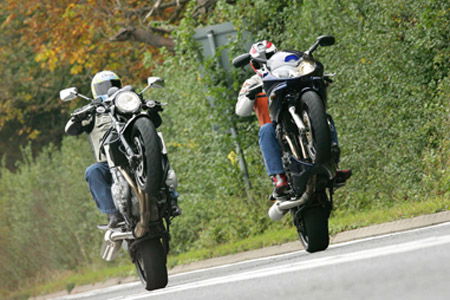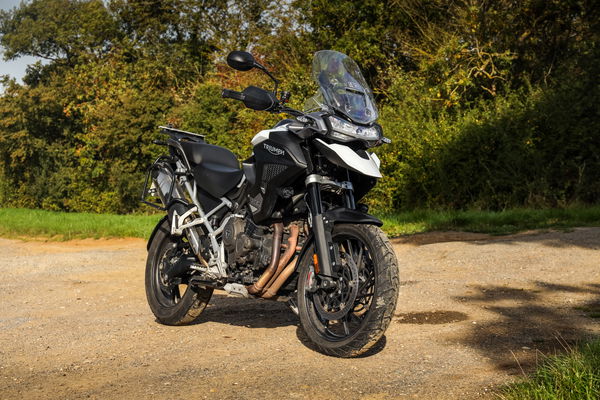Road Test: Suzuki Bandit 1200 VS 1250
With a cult following that makes Scientology look like a small book club gathering, Suzuki’s Bandit 1200 has brought big-bore grunt to the biking masses. Does the new water-cooled engine continue this reign, or relegate it now to a forgotten religion?

Links: Suzuki Bandit 1200S owners review and Niall'Mackenzie's Bandit 1200S review.
 |
Ask most riders what bike they think did the most to define the 1990s and they will probably say Ducati’s 916, Honda’s FireBlade or Suzuki’s GSX-R750. Which is fair enough, as those have always been the attention grabbers, but there is a bike that had a far more subtle influence during the same period – Suzuki’s Bandit 1200.
Like a sleeper secret agent the Bandit has been doing its part to corrupt a generation of bikers into its wicked ways since it was launched in 1996. This big-bore monster was the first proper streetbike, boasting an air/oil-cooled 1,157cc motor that was very closely related to the legendary GSX-R1100’s lump while its styling was simple, naked and designed to show off this heart of metal. It wheelied like a banshee and went round corners, too. A perfect example of the philosophy keep it simple.
Throughout its eleven-year lifespan both the look and the physical components of the Bandit 1200 remained virtually unchanged. A few subtle tweaks here and there freshened it up while a stiffer chassis in 2005 provided a stopgap model for what was to come. In 2007 Suzuki took the plunge and fitted a new engine into the Bandit 1200, and not just any engine, a brand new water-cooled unit designed specifically for the bike. The Bandit was no longer living in the past, it now had its own heart as well as a new attitude. But it also had a new market positioning.
When it was launched the Bandit was the only big bore streetbike around. Now the market is flooded with them and the big Suzuki has been forced to find a new niche. Rather than chase the performance crowd with alloy frames, inverted forks, radial brakes and sharp styling the Bandit has pitched itself at the more budget-conscious buyer. With a price tag of £5,399 for a naked 1250 or £5,799 for a half-faired with ABS the Bandit is now a big-engined, classic-styled do it all machine. Is this a step in the right direction or has Suzuki sucked all the life out of a generation-defining machine?
ENGINES
Having spent nearly quarter of a century churning out what is essentially an unchanged motor there are no surprises that the old 1200 engine feels completely sorted. We have been harping on a lot recently about Euro 3 and emissions laws so I’ll skirt over the fact that if it wasn’t for this legislation, the chances are that the Bandit’s engine would have remained air-cooled until the sun finally exploded and all life on earth was wiped out. And even then somewhere on a distant star a little green man would still be desperately tuning up one of these lumps for drag racing.
Owners of the GSX-R1100 (for this was the first bike to use the motor) must have thought they’d bought the Millenium Falcon by mistake in 1986, because even by modern standards the engine is a beauty. It must have kicked the arse out of the competition of the day. Back to back with the new water-cooled engine the old one feels far smoother. It’s an effortless engine to use. There is no fuss or drama, just a huge mountain of torque that is delivered in a perfectly smooth fashion. In comparison the new engine feels a bit less refined, has slightly more vibrations and just lacks that overall level of finish. It feels a bit like a cheap engine, which it is. But it’s still a strong powerplant and true to the Bandit’s values in every way.
I’m always reminded of a turbine engine when I ride the new 1250. In the redesign as well as a water jacket Suzuki did a load of internal work to make the motor spin up faster and give it even more torque. Open the throttle with the revs as low as 3,700rpm and the 1250 takes off like a cheetah. To all intents and purposes this is a monster twist-and-go engine, such is the infrequency that you have to change out of top. Which is a good thing because the gearbox is a step backwards. It’s not imprecise, just bloody loud and very clunky with every ratio change. It sounds like a little man inside the engine is physically hitting the cogs home with a hammer, and the throttle pick-up isn’t brilliant. Riding the carbed bike back to back with the injected one highlights just how smooth the initial pick up with carbs is. But carbs are dead now, and a little throttle snatch is just something we all just have to accept until it gets smoothed out in due course.
CHASSIS
Although both Bandits share what looks like an identical steel cradle chassis nothing could be further from the truth. Yes, the chassis’ design is similar, but the newer bike’s is stiffer and the suspension far, far superior. There is a reason that loads of Bandit 1200 owners tend to modify their bike with handling upgrades. Quite simply the stock units are crap and lose any resemblance of damping within a few years. Cornering on a second-hand Bandit is more of a case of brake, turn-in, wait for the pogo-effect to stop, then power out. Not so with the 1250, even if it is a new bike. Far firmer fork springs, an upgraded rear shock and improved damping all round means this bike corners, and does it well. Although it’s not as balanced as a modern performance streetbike the Bandit 1250 is more than capable of providing the rider with a bike that can be fun on the back roads without the feeling of riding a slightly out of control air-bed at speed.
And it’s comfortable too. The new Bandit 1250 shares an almost identical riding position to the old Bandit, a factor that made it far easier for Suzuki to slide the Bandit towards the sports touring sector. For day-to-day riding few bikes offer the Bandit’s levels of comfort, excellent 150-plus mile tank range and awesome engine grunt. As for the brakes, well Bandit brakes have never really been that good from day one. Both bikes share identical six-piston Tokico set-ups with the modern bike’s feeling better simply due to the fact they haven’t gone through a winter yet. Give them a few years and, like the old 1200s, they will be requiring a set of steel lines and some better brake pads.
STYLING
Umm, bit of a quick one this. The only real styling changes of any note happened in 2005 when the Bandit 1200 was tweaked to make it look like the new Bandit 650. The clocks were changed to the new style with a digital speedo and analogue clock (previously both dials were analogue). Unfortunately the horrible fake chrome surround was retained. A few bits of plastic were altered here and there, the most noticeable being the half-faired Bandit’s nose fairing’s light, but you’d struggle to really spot any significant changes. The Bandit has never won any beauty contests, never even wanted to, but it’s a solid-looking bike if you’re more worried about how your bike performs rather than the details of how it looks.
CONCLUSION
With the introduction of the 1250 Suzuki has moved the Bandit a considerable step forward. Not only is the chassis far superior the finish seems better, the price is simply stunning and the ride hugely improved. The only part of the old Bandit that really holds a candle to the new one is the engine, which is still superb. If your budget is tight an old Bandit 1200 with re-valved forks and a new shock would be a great buy, but if you look at the current finance deals around a new bike often makes more financial sense. The new bike has it.
FACTFILE 2007 SUZUKI BANDIT 1250
Price: £5,250
Engine: 1,255cc, liquid-cooled, DOHC, 16-valve inline four
Power: 100bhp @ 7,900rpm (c)
Torque: 80lb.ft @ 3,700rpm (c)
Front suspension: 43mm RWU forks, adjustable preload
Rear suspension: Uni-Trak monoshock, adjustable preload
Front brake: 310mm discs, four-piston Tokico calipers
Rear brake: 240mm disc, single piston caliper
Weight: 244kg wet (t)
Seat height: 810mm
Fuel capacity: 19 litres
Top speed: 144.7mph (t)
Quarter mile: 12.07sec@116mph
FACTFILE SUZUKI BANDIT 1200S
Price: £3,000
Engine: 1,157cc, air-cooled, DOHC, 16-valve inline four
Power: 98.4bhp @ 7,900rpm (t)
Torque: 69.4lb.ft @ 6,900rpm (t)
Front suspension: 43mm RWU forks, adjustable preload
Rear suspension: Uni-Trak monoshock, adjustable preload
Front brake: 310mm discs, four-piston Tokico calipers
Rear brake: 240mm disc, single piston caliper
Weight: 245kg wet (t)
Seat height: 805mm
Fuel capacity: 20 litres
Top speed: 139.2mph (t)
Quarter mile: 11.54sec@129mph











